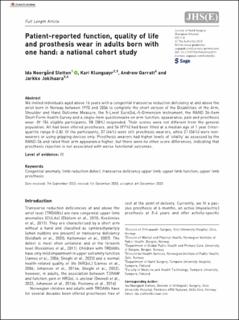Patient-reported function, quality of life and prosthesis wear in adults born with one hand: a national cohort study
Journal article, Peer reviewed
Published version

Åpne
Permanent lenke
https://hdl.handle.net/11250/3123818Utgivelsesdato
2023Metadata
Vis full innførselSamlinger
Sammendrag
We invited individuals aged above 16 years with a congenital transverse reduction deficiency at and above the wrist born in Norway between 1970 and 2006 to complete the short version of the Disabilities of the Arm, Shoulder and Hand Outcome Measure, the 5-Level EuroQoL-5-Dimension instrument, the RAND 36-Item Short Form Health Survey and a single-item questionnaire on arm function, appearance, pain and prosthesis wear. Of 154 eligible participants, 58 (38%) responded. Their scores were not different from the general population. All had been offered prostheses, and 56 (97%) had been fitted at a median age of 1 year (interquartile range 0–2.8). Of the participants, 37 (64%) were still prosthesis wearers, while 21 (36%) were non-wearers or using gripping devices only. Prosthesis wearers had higher levels of ‘vitality’ as assessed by the RAND-36 and rated their arm appearance higher, but there were no other score differences, indicating that prosthesis rejection is not associated with worse functional outcomes.
